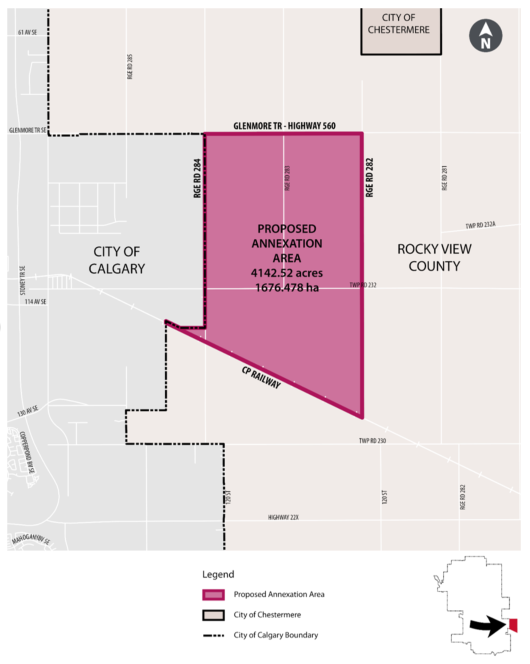Rocky View County Industrial Land Annexation
Project update
The City of Calgary has placed work on the proposed annexation of land within Rocky View County on hold, pending the outcome of the Prairie Economic Gateway Initiative.
For more information on the initiative, please visit:
Project overview
In September, City Council unanimously agreed to proceed with plans to initiate the annexation process for land currently within Rocky View County.
City Administration submitted a formal letter of initiation to begin the annexation process to acquire industrial lands within the boundaries of:
- North: Highway 560
- East: Range Road 282
- South: Canada Pacific Railway line
- West: Range Road 284
The letter sent to the Land and Property Rights Tribunal fulfills the requirements of Section 116 of the Municipal Government Act.
We are planning for Calgary’s industrial future and this area will ensure we maintain an adequate long-term land supply to accommodate the evolving needs of industrial developers.
These lands represent 1,676 hectares of space that aligns with The City’s future growth plans for the industrial sector of Calgary. The Next Generation Planning strategy is creating new ways of planning that support growth and change in Calgary now, and for the next generation.
The proposed annexation area was first identified as future-development land for The City in 2006, with a jointly-approved Rocky View – Calgary Intermunicipal Development Plan formalized in 2007. When annexed, the lands would be developed under The City’s jurisdiction.
Letters to notify our intent have been sent to landowners within the proposed annexation area, as well as those within 1.6 km of the area, as part of the process. Landowners and the general public will have an opportunity to provide input through a series of open houses (or other means depending on current health measures) that will be scheduled in the first half of 2022.

-
Learn more about annexation, a provincially-legislated process governed by the Municipal Government Act that transfers land from one municipality to another to accommodate growth.
Frequently asked questions
Where can I find more information about the annexation process in Alberta?
Annexation is a provincially-legislated process governed under Municipal Government Act. Lands are transferred from one municipality to another to accommodate future urban growth and development. The new municipality provides services, and their regulatory authority to protect public health and safety.
In Alberta, annexations are regulated by the Land and Property Rights Tribunal (formally Municipal Government Board). The annexation process involves negotiations between local governments, public engagement with property owners, a formal review by the Land and Property Rights Tribunal, and the Minister of Municipal Affairs. The Minister of Affairs brings forward the annexation orders to Cabinet. If approved or approved in part, the Lieutenant Governor of Alberta signs the order. Further details about the annexation process can be found on the Land and Property Rights Tribunal website.
For more information about land annexation, please visit calgary.ca/annexation
Learn how we plan for Calgary's future or view the History of Annexation map.
Why did The City initiate annexation of this area?
The proposed annexation area was identified as part of The City’s industrial growth area - first in the 2007 Annexation Agreement (Board Order: MGB079/07), and later formalized as part of the Rocky View County – City of Calgary Intermunicipal Development Plan (IDP).
These lands represent 1,676 hectares of space that aligns with The City’s future growth plans for Calgary. Annexation is a way to further our ability to grow the industrial sector by ensuring we maintain an adequate long-term land supply to accommodate the evolving needs of industry developers.
What value does annexation bring Calgary and landowners?
Developing these lands to The City’s standards for transportation and utilities services not only increases land value but is also a more efficient use of resources.
Industrial lands also generate taxes to provide for various services. By annexing lands, The City can continue to provide new economic and employment opportunities and spur economic growth within our boundaries in the long-term.
How does Calgary plan for future growth & development?
We're changing the way we plan our city through what we call Next Generation Planning. It is how we are carrying out the Municipal Development Plan and Calgary Transportation Plan to make sure our citizens and the people who move to and invest in Calgary can make a great life and great living in our city.
The Municipal Development Plan and Calgary Transportation Plan are The City’s long-range land use and transportation plans that look 60 years into the future. These Plans help shape how the communities we live and work in grow, develop and evolve over time.
Strong industrial areas are the foundation for Calgary's role as an inland port and distribution centre for western Canada. The Citywide Growth Strategy supports Calgary’s economic growth with an action plan that diversifies and supports the industrial sector.
In collaboration with the stakeholders, The City can help the industrial sector through five categories of actions:
- Development enabling regulatory improvements: Actions that streamline regulations and update guiding policy
- Public realm, infrastructure, and servicing investment: Actions that use public investment in supporting infrastructure to enable growth.
- Cost: Actions to reduce development costs and charges
- Public Lands: Actions in which The City’s role as a land developer can support elements of market activity.
- Business Environment: Actions that support existing business and encourages new ones.
Does annexation mean immediate development?
Annexation of land does not mean immediate development. Development are a product of inputs such as planning, servicing and market demand. The City has a well-developed process to realize development in locations that are or can be serviced with high quality infrastructure such as transportation, safety, and utilities.
How long does the annexation process take?
We are at the initial stages of annexation and cannot estimate how long this process will take. The annexation process can be lengthy as municipalities negotiate and work through the requirements set out by the Municipal Government Act.

